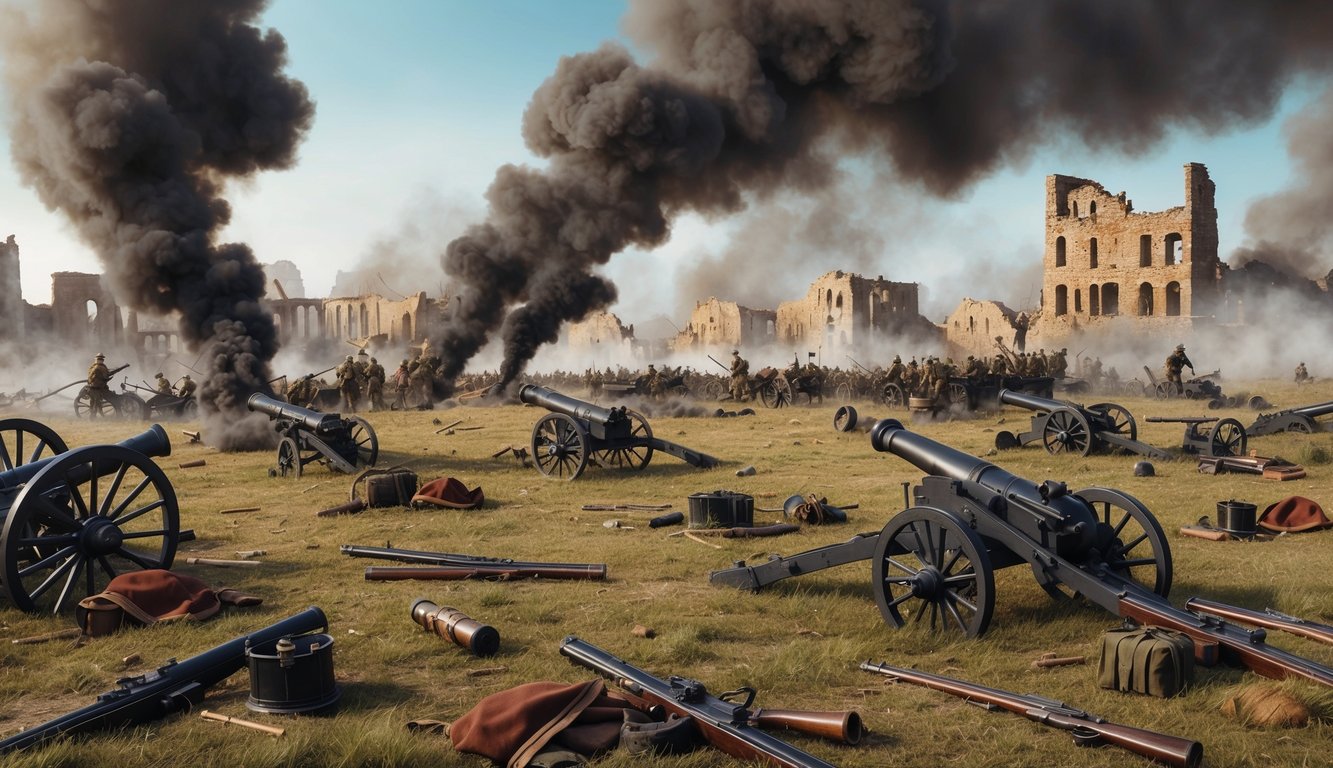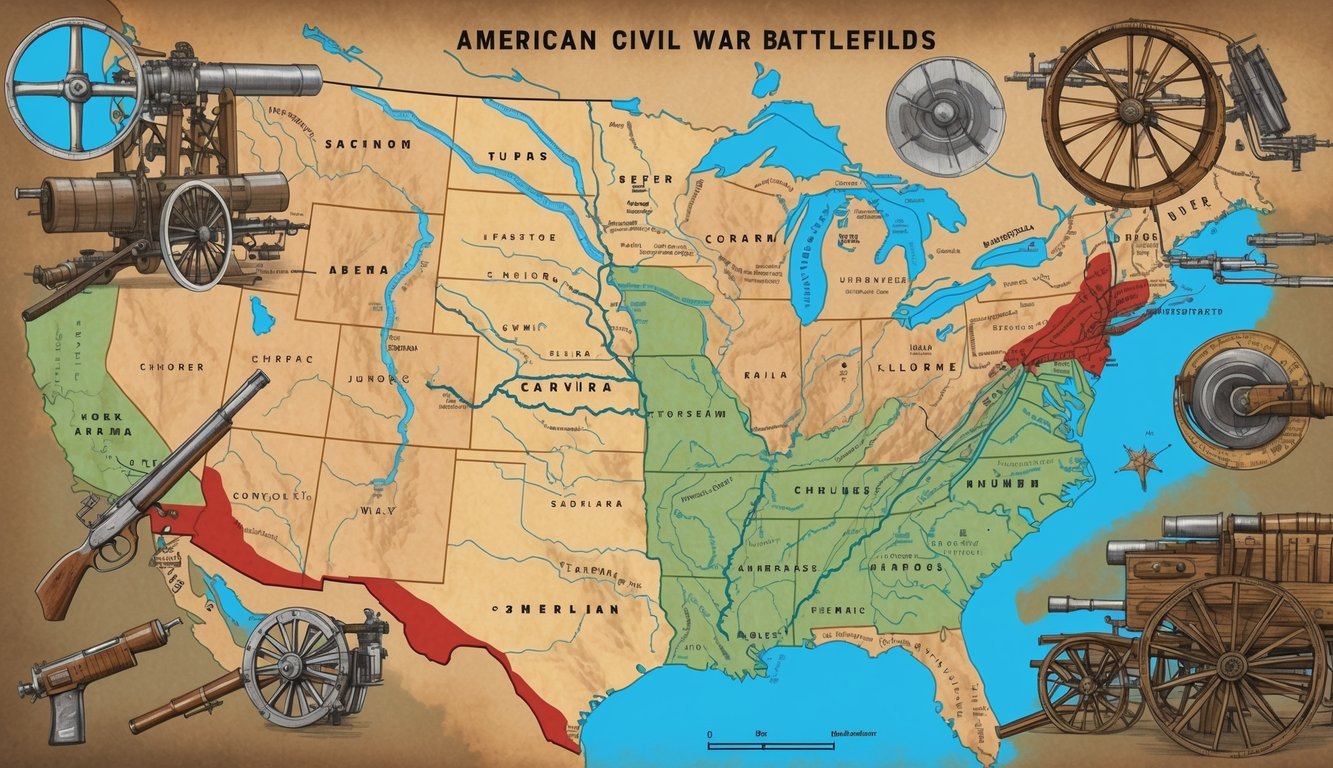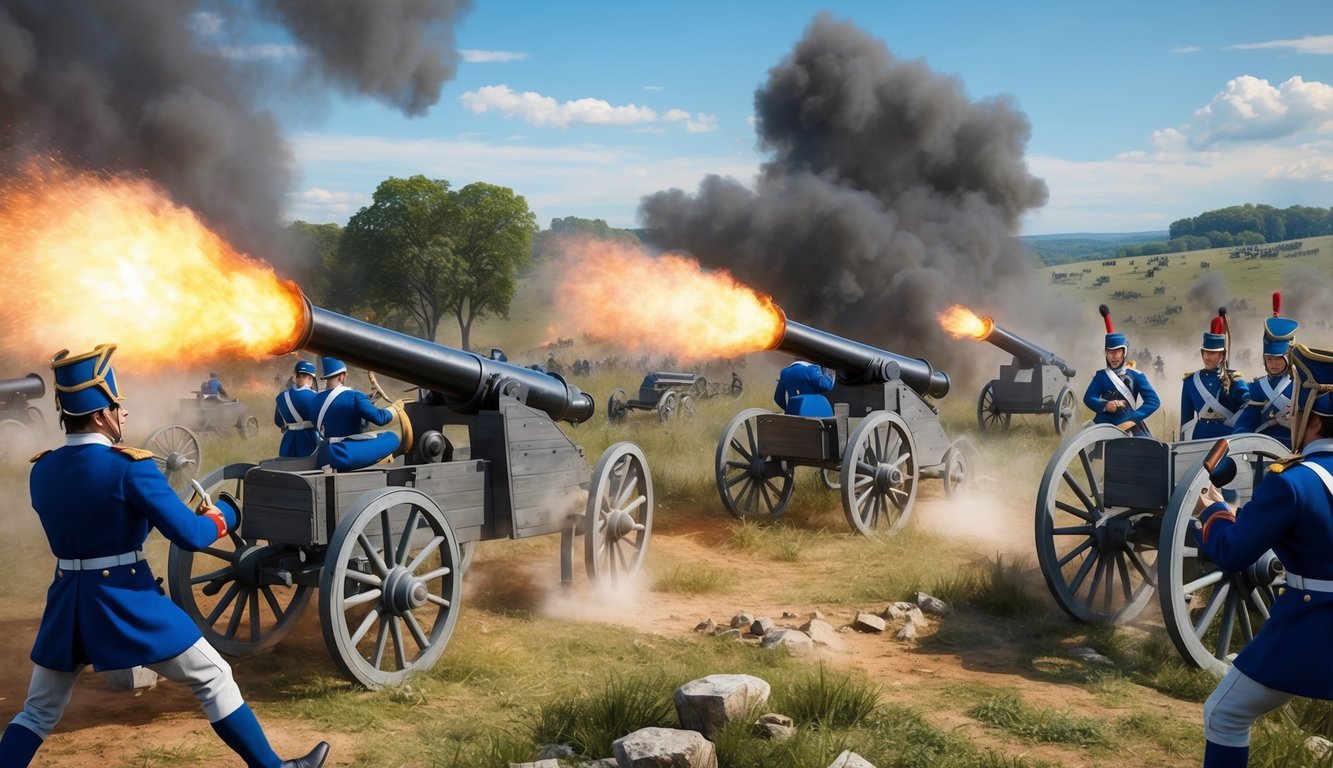The American Civil War was not solely about the confrontation between soldiers in blue and gray uniforms on the battlefield.
Instead, it served as a catalyst for innovation that fundamentally changed the nature of warfare.
You may be surprised to discover that numerous technologies we now consider commonplace were born out of this significant conflict.
From the advent of rifled muskets to the incorporation of submarines and aerial reconnaissance, the Civil War emerged as a proving ground for groundbreaking military technologies.
As armies faced these new instruments of war, strategies adapted quickly.
Generals had to modify their tactics to accommodate longer weapon ranges and expedited communications.
Traditional formations on the battlefield soon transitioned to more flexible and dynamic combat styles.
One can only imagine the difficulties of commanding troops in such a rapidly evolving wartime environment.
The effects of these technological advancements were not confined to the battlefield.
They transformed entire societies, impacting everything from medical practices to industrial production.
The consequences of the Civil War extended beyond military engagements, influencing every facet of American life and playing a crucial role in the nation’s rise as a global power.
Key Takeaways
- The Civil War propelled swift technological advancements in weaponry and communication.
- Military tactics evolved to harmonize with new technologies and shifting battlefield dynamics.
- The war’s technological progress had extensive implications for American society and industry.
Origins and Overview
The American Civil War was born out of long-standing tensions regarding slavery and states’ rights.
Influential figures such as Abraham Lincoln and military leaders significantly influenced the war’s trajectory through their decisions and strategies.
Emergence of Conflict
You might be curious about how the Civil War commenced.
Debates between the North and South had been simmering for years.
Slavery stood as the central issue, with the North advocating for abolition and the South striving to maintain it.
The election of Abraham Lincoln in 1860 pushed many Southern states over the edge, fearing his anti-slavery stance threatened their way of life.
Consequently, eleven Southern states chose to secede from the Union, compelling Lincoln to rally troops to suppress the rebellion.
The first shots were fired at Fort Sumter in April 1861, signaling the war’s official onset.
Major Contributors
Numerous key figures played significant roles in the Civil War’s shaping.
Abraham Lincoln, the United States’ 16th President, is perhaps the most recognized figure.
His leadership and resolve to preserve the Union were crucial.
On the military side, Ulysses S. Grant emerged as a proficient Union general, using aggressive tactics and strategic insight to shift the war’s favor toward the North.
For the Confederacy, General Robert E. Lee became a renowned leader, utilizing his tactical prowess to keep the Southern forces engaged despite their resource limitations.
Other notable commanders included:
- George B. McClellan: Union general noted for his cautious approach
- Braxton Bragg: Confederate general who led pivotal campaigns in the Western Theater
These individuals, among countless others, guided the war’s trajectory through their choices both on and off the battlefield.
Military Strategies
The Civil War introduced distinct strategies by both sides in their quests for victory.
The Union embarked on a comprehensive plan to vanquish the Confederacy, while the Rebels sought to endure the North’s resolve.
Union Strategy
You might be astonished to learn that the Union’s strategy evolved throughout the war.
Initially, General Winfield Scott proposed the “Anaconda Plan,” aiming to blockade Southern ports and secure control over the Mississippi River to economically suffocate the Confederacy.
As the war continued, the Union adopted a more aggressive approach, exemplified by General Ulysses S. Grant’s strategy of launching simultaneous offensives on multiple fronts.
This tactic aimed to overwhelm Confederate forces and prevent troop reinforcements to vulnerable locations.
The Union also focused on targeting Southern resources and infrastructure, seen in Sherman’s “March to the Sea,” which devastated Georgia’s economy and weakened the morale of the Confederate populace.
Confederate Strategy
The Confederacy primarily employed a defensive strategy, striving to protect its extensive territory while looking to deplete Northern resolve.
Initially, Confederate leaders sought a negotiated settlement by winning defensive engagements to demonstrate the war’s costliness for the North.
This strategy began to evolve as the conflict progressed, with Confederates undertaking several offensives, including Lee’s incursion into Pennsylvania, in hopes of achieving a decisive victory and gaining foreign support.
Relying on a network of interior communication lines enabled the South to swiftly reposition troops to counter Union attacks despite their resource constraints.
Technological Advances
The Civil War inspired a wave of technological innovation that transformed combat operations.
New weapons, naval innovations, and communication advancements changed how battles were fought and how armies operated.
Ironclads and Naval Warfare
You may be familiar with the notable ironclad engagement between the USS Monitor and CSS Virginia.
These armored vessels revolutionized naval warfare, becoming nearly impervious to cannon fire due to their robust iron plating.
Both the Union and Confederacy raced to assemble their own ironclad fleets.
However, ironclads were not the extent of naval innovation during the war; submarines were introduced, with mixed success.
The Confederate H. L. Hunley made history as the first submarine to sink an enemy ship in combat.
These advancements heralded the dawn of modern naval warfare, rendering wooden ships obsolete almost instantly.
Artillery and Firearms
A soldier in the Civil War would have observed a significant transformation in firepower.
Rifled muskets replaced smooth-bore firearms, exponentially improving accuracy and effective range.
The Minié ball, a conical projectile, made these rifles even more lethal.
Repeating rifles such as the Spencer provided soldiers with rapid-fire capabilities, allowing multiple shots to be fired without the need for reloading—a significant advantage in battle.
Improvements in artillery also marked this era.
Rifled cannons offered increased range and precision, while explosive shells inflicted greater devastation compared to solid shots.
These advancements in weaponry contributed to deadlier battlefields, necessitating a shift in tactics to accommodate the increased lethality.
Intelligence and Communication
The significance of communication advancements during the war effort may not be immediately evident.
The telegraph revolutionized long-distance communication, enabling generals to coordinate strategies and receive updates from the front lines in near real-time.
The U.S. Military Telegraph Corps became crucial to the Union Army’s success, laying thousands of miles of telegraph wire to maintain connections among commanders.
Railroads also played an essential role in logistics, facilitating the swift movement of troops and supplies that dramatically altered the speed and scale of warfare.
Additionally, reconnaissance balloons offered leaders aerial views of enemy positions, representing an early form of intelligence gathering from the skies.
These innovations in communication and intelligence allowed for enhanced coordination of large armies over vast distances.
Key Battles and Campaigns
Several key battles significantly influenced the direction of the American Civil War.
These engagements revealed the changing strategies and the devastating impact of emerging technologies.
Early Engagements
The initial battles established the long struggle that lay ahead.
Fort Sumter, fired upon in April 1861, marked the official commencement of hostilities, characterized by the Confederate bombardment resulting in the surrender of Union forces.
The First Battle of Bull Run in July 1861 shocked both sides, shattering hopes for a quick resolution. Union troops fled in disarray, surprising Southern forces.
This confrontation demonstrated the essential need for better-trained troops for the ensuing campaigns.
Turning Points
Gettysburg is perhaps the most recognizable battle of the war.
In July 1863, massive armies clashed in Pennsylvania, and General Lee’s gamble to invade the North ultimately failed.
The Union’s victory not only lifted Northern morale but also signaled a turning point in the Confederate’s fortunes.
The Vicksburg Campaign highlighted the strategic importance of the Mississippi River.
You would have witnessed General Grant’s innovative approach in isolating the city and bombarding it for weeks.
The city’s fall on July 4, 1863, effectively divided the Confederacy.
The Path to Surrender
Sherman’s March to the Sea in late 1864 brought the war’s destruction to Southern civilians directly, as you would have seen a swath of devastation stretching 60 miles through Georgia.
This campaign shattered the South’s resolve to continue the fight.
The Overland Campaign of 1864 witnessed unrelenting combat between Grant and Lee.
You’d have been astonished by the enormous casualties witnessed in battles such as the Wilderness and Cold Harbor.
This relentless strategy ultimately compelled Lee to surrender at Appomattox in April 1865, marking the war’s effective conclusion.
Impact of Technology on Warfare
Throughout the Civil War, rapid technological developments profoundly transformed warfare.
Innovations in weaponry, naval tactics, and medical advancements reshaped the experience of both soldiers and civilians.
Innovations in Weapons
A rifle used by a Civil War soldier would have been significantly more accurate and lethal compared to those employed in earlier conflicts.
The rifled musket expanded effective firing range to between 300 and 500 yards, a marked improvement over smoothbore muskets.
The standard issue would likely have been a .58 caliber rifle equipped with rifled barrels and conical Minié balls, which expanded upon firing to grip the rifling and thus enhance accuracy and range.
Repeating rifles such as the Spencer and Henry provided the ability to fire multiple rounds without frequent reloading.
Although not widely used, these firearms anticipated future advancements in rapid-fire weaponry.
Artillery saw substantial advancements as well.
Rifled cannons capable of firing exploding shells offered enhanced range and destructive capability.
The Gatling gun, an early machine gun, showcased the potential for rapid firing, reaching rates of up to 200 rounds per minute.
Changes in Naval Combat
The Civil War marked a pivotal shift in naval warfare.
You would witness the emergence of ironclad warships, fundamentally altering how naval engagements were conducted.
The most notable clash between the USS Monitor and CSS Virginia rendered wooden ships obsolete almost overnight.
The iron-armored vessels featured rotating gun turrets and enhanced cannons for both offensive and defensive strategies.
Submarines, as exemplified by the Confederate H.L. Hunley, made their combat debut, signaling a shift towards future underwater warfare.
Additionally, the first effective use of naval mines (known then as “torpedoes”) and rudimentary torpedo boats posed new threats to maritime operations.
Medical Advances
If you were a wounded soldier, you would see substantial medical developments throughout the war.
The use of anesthesia became widespread, allowing for more advanced surgical procedures.
The establishment of ambulance corps and field hospitals significantly improved survival rates.
Innovations in treating fractures and performing amputations saved numerous lives.
For those who lost limbs, advances in prosthetics arose during this time.
As well, embalming practices were refined to preserve bodies for transport, which led to changes in the American funeral industry post-war.
Reconnaissance and Espionage
Hot air balloons played an indispensable role in Civil War reconnaissance efforts.
Union forces deployed these airborne observation points to collect intelligence on Confederate troop movements and fortifications.
Submarines also made their first combat appearances, with the H.L. Hunley achieving the notable feat of sinking an enemy vessel.
This marked the beginning of a new chapter in naval warfare.
Photography transformed the public’s understanding of the conflict.
For the first time, vivid images depicting battlefields and soldiers brought the harsh realities of war into the everyday lives of Americans.
Economic and Industrial Factors
The Civil War acted as a catalyst for America’s industrial revolution.
Factories ramped up production of weapons, uniforms, and other necessities to support the war effort.
The North’s extensive railroad network provided a significant advantage, enabling the swift deployment of troops and efficient supply lines.
The Union’s naval blockade crippled the Southern economy, particularly its cotton industry.
This strategy, referred to as the Anaconda Plan, gradually strangled the resources needed by the Confederacy.
Role of Media and Communication
The telegraph revolutionized the dissemination of war-related news.
Reporters could file updates from the front lines almost instantaneously.
Newspapers significantly influenced public perception by presenting detailed battle reports complemented by sketches or photographs.
The postal service maintained connections between soldiers and their families, with letters uplifting morale while providing personal accounts of wartime experiences.
Signal flags and coded messages enhanced on-the-ground communication, utilizing colorful flags atop hills to relay crucial information between units.
Aftermath and Legacy

The American Civil War indelibly impacted the nation’s history and future.
Its aftermath ushered in major transformations in society, government, and technology that would influence the United States for generations.
Post-War Reconstruction
In the aftermath of the war, a period of rebuilding and reunification commenced, known as Reconstruction.
The federal government faced the daunting challenge of reintegrating the Southern states.
Lincoln’s Emancipation Proclamation laid the groundwork for ending slavery, culminating in the 13th Amendment.
You would have observed newly freed African Americans fighting for citizenship and voting rights through the 14th and 15th Amendments.
However, these advancements faced sharp opposition in the South, where former Confederate states enacted “Black Codes” to curb the rights of freedmen.
Additionally, this era saw the emergence of groups like the Ku Klux Klan, which resorted to violence in their opposition to equal rights for African Americans.
Despite these adversities, there were early signs of African American political participation, as well as the establishment of schools and churches within liberated communities.
Technological Legacy
The technological growth during the Civil War not only transformed military engagements but also had lasting effects on civilian life.
Numerous innovations developed due to military needs found peacetime applications.
The telegraph, vital for wartime communication, saw rapid expansion across the country in the post-war period.
Improvements in food preservation during the war contributed to the rise of the canning industry.
Significant development of railroads, which were essential for troop and material movement during the conflict, surged in the following years, promoting economic growth.
The war’s medical advancements, encompassing refined surgical methods and anesthesia use, transitioned into civilian healthcare.
You’d also note that the standardization practices developed for military supplies laid the groundwork for America’s industrial revolution.
Frequently Asked Questions

The American Civil War witnessed extraordinary technological innovations that reshaped both warfare and society.
These advancements significantly influenced battle tactics, soldier health, and military strategies in lasting ways.
What technological advancements were prominent during the Civil War?
Rifled muskets increased accuracy and firing range significantly.
The telegraph enabled swift long-distance communication.
Ironclad ships changed naval combat completely.
Photography documented the war more vividly than ever before.
Railroads facilitated rapid troop and supply movements.
How did new weapons influence tactics used in Civil War battles?
Rifled muskets rendered traditional massed infantry assaults exceedingly deadly, shifting tactics toward more defensive measures and trench warfare.
Artillery became more accurate over greater ranges, while cavalry evolved from a focus on shock charges to roles in reconnaissance and raiding.
In what ways did Civil War technology impact soldiers’ health and safety?
Advancements in medical techniques and the establishment of ambulance services saved many lives.
The adoption of anesthesia allowed for more complex surgical procedures.
Nonetheless, emerging rifle technology resulted in more severe injuries, and the lack of sanitary conditions and germ theory understanding led to widespread disease outbreaks among troops.
Can you name some key inventions that emerged during the Civil War?
Major inventions included the Gatling gun, an early form of machine gun developed in 1861; advancements in submarine technology, exemplified by the H.L. Hunley; observation balloons that enhanced battlefield intelligence; and early concepts of aircraft carriers.
What role did railroads and other transportation forms play in Civil War strategies?
Railroads significantly accelerated troop and supply deployments, making efficient lines of communication crucial to military strategies.
Rivers and canals were pivotal for transporting gunboats and resources, while improved roads supported quicker troop movements and logistics.
Why are Civil War battle tactics often seen as outdated despite the era’s technological innovations?
Many commanders were slow to modify traditional tactics to fully leverage new weapon capabilities.
Conventional strategies persisted despite rising casualties.
The complete impact of emerging technologies was not immediately grasped, and some, like trench warfare, foreshadowed future conflicts but were not fully adopted at the time.

